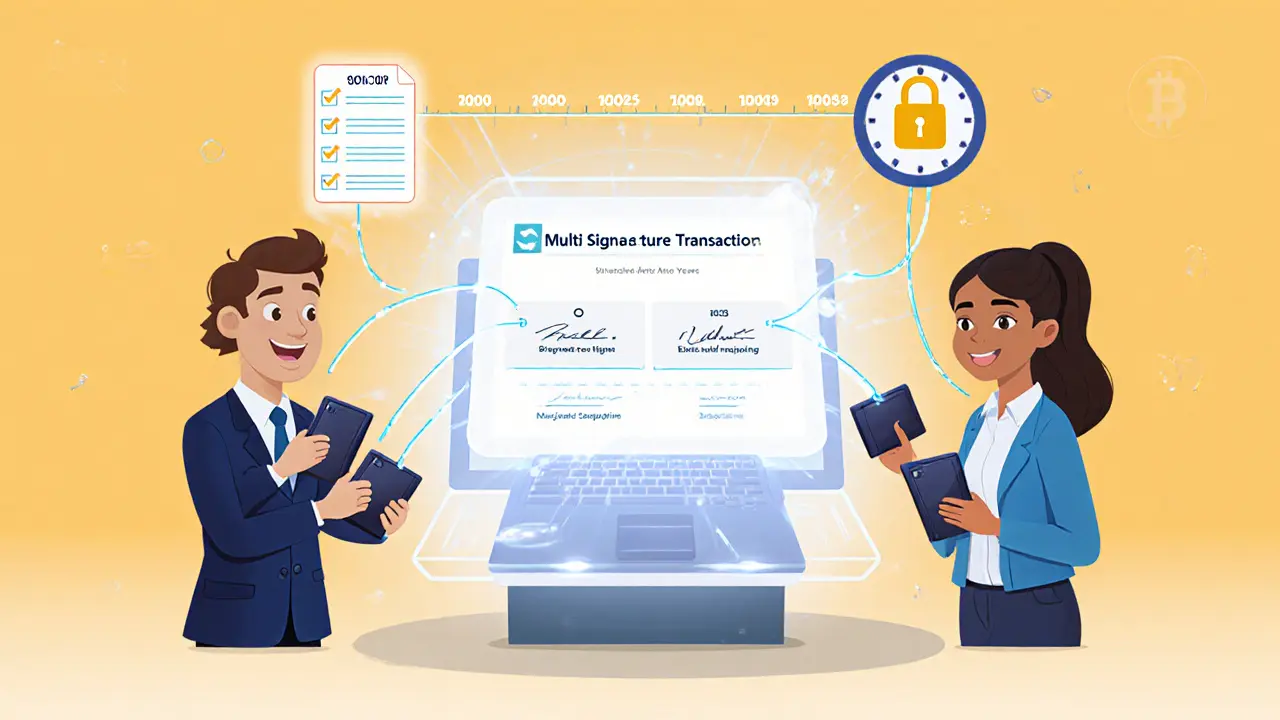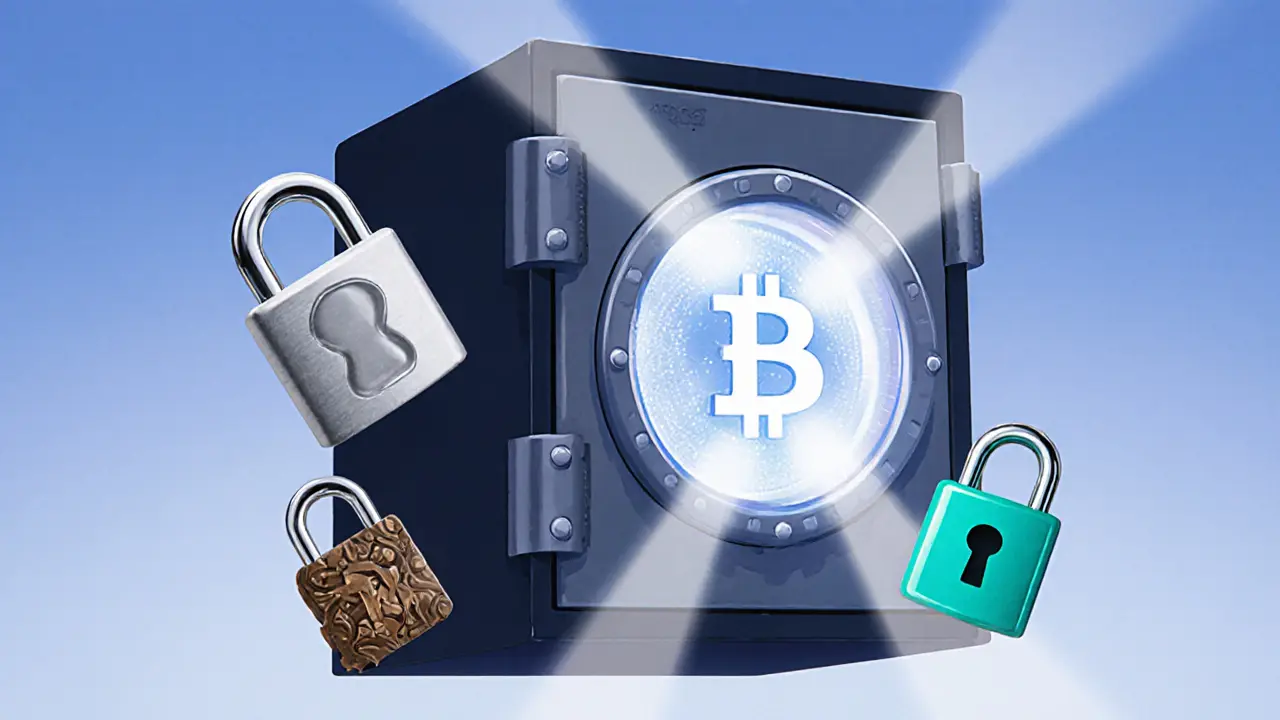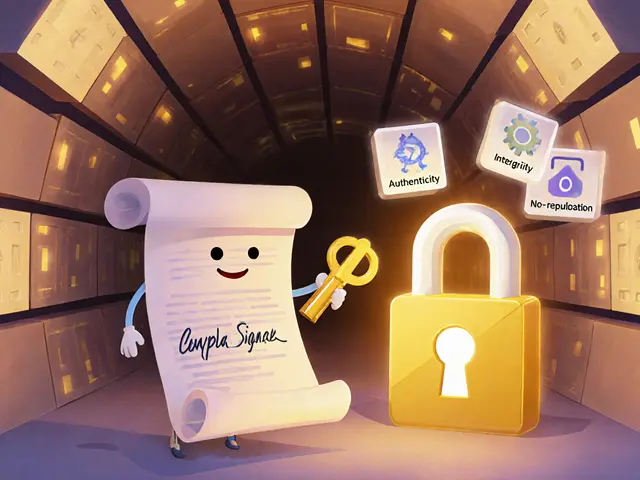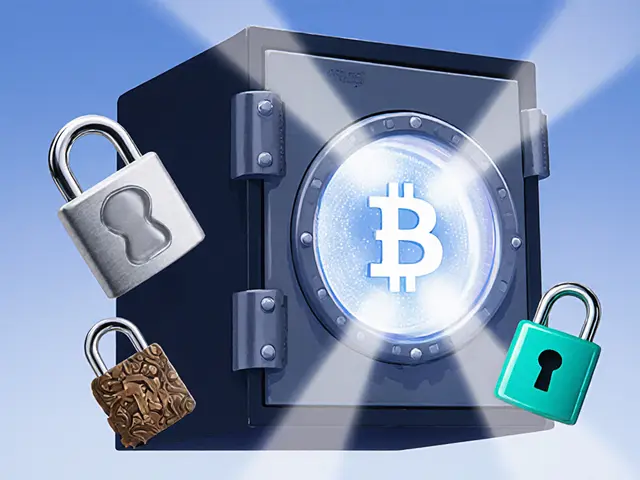When you hear the term MultiSig wallet is a cryptocurrency wallet that requires multiple cryptographic signatures (M‑of‑N) before a transaction can be executed, think of a safe‑deposit box with several locks. Only when the right combination of keys is turned does the box open. This model eliminates the single‑point‑of‑failure that plagued early crypto hacks and tragedies like the 2019 Quadriga loss. Below you’ll find a step‑by‑step playbook that turns the concept into a rock‑solid security shield for any digital asset holder.
Understand the M‑of‑N Signature Scheme
At the heart of every MultiSig wallet sits the M‑of‑N scheme where M is the minimum number of signatures required out of N total possible signers. A 2‑of‑3 setup means any two of three designated keys can approve a spend, while a 3‑of‑5 arrangement needs three out of five. Choosing the right ratio hinges on your risk tolerance and operational workflow. Smaller teams often go for 2‑of‑3 for speed; larger institutions prefer 3‑of‑5 to spread trust across departments.
Pick a Trusted MultiSig Provider
Not all wallets are created equal. The market’s leading options include Electrum a Bitcoin‑focused client that supports customizable M‑of‑N setups, Gnosis Safe an Ethereum‑centric smart‑contract wallet praised for its UI and modular security plugins, and Casa a multi‑asset service that bundles hardware wallets with managed multisig vaults. Choose a provider that offers open‑source contracts, regular audits, and a clear roadmap for future updates.
Integrate Diverse Hardware Wallets
Hardware wallets are the first line of defense against key extraction. Best practice demands using hardware wallets physical devices that store private keys offline and sign transactions in a tamper‑resistant environment from different manufacturers - for example, a Ledger Nano X, a Trezor Model T, and a Coldcard. Mixing brands mitigates the risk of a single firmware vulnerability compromising all signers. Keep each device in a separate, geographically dispersed location: a home safe, an office deposit box, and a trusted family member’s lockbox.
Deploy Time‑Lock and Recovery Mechanisms
Advanced wallets let you embed a time‑lock feature an automatic rule that relaxes signature requirements after a predefined date. A 2‑of‑3 wallet could switch to 1‑of‑3 after five years, guaranteeing access if a signer becomes unavailable. Pair this with a documented recovery plan that outlines how to revoke a lost key, generate a replacement, and update the contract through the remaining owners.
Add Multi‑Factor Authentication (MFA)
Beyond the required signatures, enable multi‑factor authentication an extra verification step such as a one‑time code, biometric prompt, or hardware security key on every device that interacts with the wallet’s UI or API. MFA dramatically raises the cost for an attacker who has stolen a private key but still needs the second factor to approve a transaction.
Secure the Output Descriptor and Recovery Phrase
The Output Descriptor a script that precisely defines the MultiSig address, its M‑of‑N parameters, and associated public keys is as critical as the private keys themselves. Store the descriptor in an encrypted, air‑gapped device and create multiple backups in separate vaults. Likewise, each hardware wallet generates a 12‑ or 24‑word recovery phrase; treat it like a master key, write it on metal, and keep copies in fire‑proof containers.
Operate from Air‑Gapped or Hardened Devices
All signing actions should happen on air‑gapped devices computers or smartphones that never connect to the internet, reducing malware exposure. Use a dedicated OS such as Qubes or Hardened Linux, and never reuse the same machine for everyday browsing or email. If you must use a connected device, run the signing software inside a virtual machine that isolates the wallet from the host OS.
Implement Real‑Time Monitoring
Enable a watch‑tower service like Safe Watcher or a custom blockchain node that pushes alerts the moment a transaction proposal, signature, or owner change appears on‑chain. Instant notifications give you the chance to freeze a wallet (if the contract permits) or initiate a revocation before funds move.

Document Procedures and Conduct Regular Audits
A well‑written SOP should cover:
- How to create a transaction, verify raw data, and collect signatures.
- Steps for adding, removing, or rotating signers using out‑of‑band verification (video call + signed message).
- Emergency recovery flows, including time‑lock activation and key replacement.
- Backup rotation schedule and test restores.
Schedule quarterly security reviews: verify that each signer’s device firmware is up‑to‑date, passwords are unique, and geographic storage locations remain secure.
Compare Common M‑of‑N Configurations
| Setup | Signatures Required | Typical Use‑Case | Security Level | Operational Complexity |
|---|---|---|---|---|
| 2‑of‑3 | 2 | Small teams, personal vaults | High - attacker needs two keys | Low - fast approvals |
| 3‑of‑5 | 3 | Enterprises, DAOs | Very high - three independent keys | Medium - more coordination |
| 4‑of‑7 | 4 | High‑value custodial services | Maximum - four distinct compromise points | High - longer decision chains |
Following these steps will make your MultiSig wallet far more resistant to attacks.
Next‑Step Checklist
- Choose the provider (Electrum, Gnosis Safe, etc.) and decide on M‑of‑N.
- Generate hardware wallet keys on separate, air‑gapped machines.
- Create the wallet, record the Output Descriptor and recovery phrases.
- Distribute devices and backup copies across three locations.
- Enable time‑lock, MFA, and real‑time monitoring.
- Write and test an SOP covering normal and emergency flows.
- Run a quarterly audit and update firmware/passwords.
Frequently Asked Questions
What is the difference between a MultiSig wallet and a regular single‑key wallet?
A single‑key wallet relies on one private key; if that key is lost, stolen, or the holder dies, the funds become inaccessible. A MultiSig wallet splits control among several keys, so no single point of failure exists. Transactions need multiple signatures, making unauthorized spending far harder.
How many signers should a small business use?
A 2‑of‑3 configuration is a sweet spot. It provides redundancy (the third key acts as a backup) while keeping approval times short. Typical roles are a finance officer, a technical lead, and an external auditor.
Can I use the same hardware wallet model for all signers?
It’s possible, but not recommended. Using distinct models (e.g., Ledger, Trezor, Coldcard) reduces the chance that a single firmware bug or supply‑chain attack compromises every signer at once.
What is a time‑lock and when should I enable it?
A time‑lock automatically relaxes the required signature count after a set date. It’s useful for long‑term vaults where a signer might become unavailable (retirement, relocation). Set the lock far enough in the future to avoid premature weakening.
How do I revoke a compromised signer?
If the contract allows, submit a transaction signed by the remaining healthy keys that calls the revocation function. The transaction replaces the old public key with a new one, restoring security without moving funds.



Comments
Sure, because adding three hardware wallets is exactly what I had free time for.
Oh great another checklist, as if my life wasn't already a circus.
Reading through the guide felt like attending a masterclass in crypto security. The breakdown of M‑of‑N ratios instantly clarified why a 2‑of‑3 setup is popular among startups. I especially appreciated the reminder that different hardware brands reduce systemic risk. Geographic distribution of keys is not just a buzzword; it can be the difference between recovery and loss. The time‑lock concept struck me as a clever safety net for long‑term vaults. Embedding MFA on every signing device raises the attack cost to an absurd level. Storing the output descriptor on an air‑gapped machine aligns with the principle of defense in depth. The suggestion to use Qubes or a hardened Linux distro resonates with my own hardening practices. Real‑time monitoring via watch‑tower services offers peace of mind that many overlook. I also liked the practical SOP checklist; it turns abstract ideas into actionable steps. Testing restores quarterly ensures that backups are not just paper tigers. The table summarizing trade‑offs between 2‑of‑3, 3‑of‑5, and 4‑of‑7 is a handy reference. Overall the guide balances theory and hands‑on advice without drowning the reader. Implementing these practices will undoubtedly raise the security posture of any crypto holder. Kudos to the author for stitching together a comprehensive playbook for 2025.
Wow, this looks like the ultimate security recipe!
Imagine the drama when a hacker finally hits a wall of signatures.
yeah, i get the idea, but *real* life is messy.
geographic dispertion is great until you forget where you put the third key.
Mixing Ledger, Trezor and Coldcard? Brilliant. It’s like having three different locks on the same door.
Nice point, but let’s be real – not everyone has three separate safes to hide their devices.
Cool guide, helped me actually set up a 2‑of‑3 wallet over the weekend.
Love the emoji‑friendly vibe! 😊 The watch‑tower suggestion is a lifesaver.
Patriotic crypto users should definitely adopt this; it keeps our digital freedom safe.
Truly insightful – the guide balances hype and substance.
Security is a dance between trust and skepticism.
Thank you for the thorough breakdown. The procedural checklist will be incorporated into our compliance framework.
Friendly heads‑up: make sure your air‑gapped machines still get occasional firmware updates – otherwise they become vulnerable.
Honestly, reading this felt like another boring tech manual.
Hey, don’t dismiss it so quickly – the multi‑sig approach really does mitigate a lot of risk for small teams.
Anyone not using multi‑sig is basically inviting theft.
While I agree with the premise, the implementation details can become overly complex for an average user.
Implementing the checklist step‑by‑step will help teams build a resilient crypto treasury. Remember to test the recovery flow regularly.
Good point about regular audits; they’re essential for maintaining confidence.
Yep, staying chill and testing backups keeps the stress low. Keep it up!